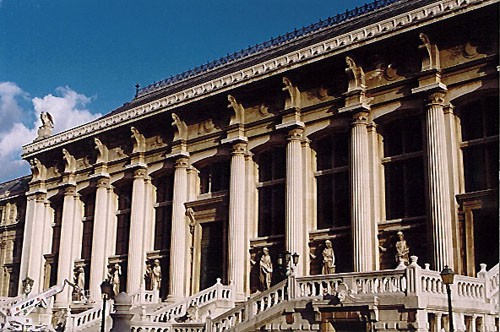On the Ile de la Cité stands today one of the oldest and most prestigious official buildings in Paris, the Palais de Justice law courts. As far back as Roman times the site was used as a place of government, and this example was followed by the succeeding Merovingian and Capetian dynasties. As the kings of France gradually began to build palaces elsewhere, the area came to be the seat of the sovereign court in the land, and hence a centre for all legal services in the capital. And this gradual evolution through history can be read in the complex architecture of the building, with components ranging in date from the thirteenth to the twentieth centuries. The following description recounts in particular the most important changes of the 19th century. In fact, significant extensions to the building were realised during the Second Empire at the instigation of the Justice Ministry and a great deal of the edifice dates from this period.
Joseph-Louis Duc (1802-1879) was put in charge of the programme for the rebuilding of the Palais de Justice, and two important constructions date from this period, namely the west façade (see above photo) and the Salle des Pas Perdus. The latter chamber, also known as the Vestibule des Assises, was begun in 1857 and finished in 1869 and it soon became the hub of the palace. Although burnt down during the Communes period it was rebuilt to the same plans. The Salle comprises two huge naves, punctuated by round-arched arcades, and gives access to several civil courts, of which one is the Chambre Dorée, a leftover from the ancient palace. Restored in 1866, burnt down in 1871 and finally rebuilt to its 16th century form by Duc, the Chambre Dorée is particularly remembered because it was the place where in 1793 the revolutionary tribunal pronounced the death sentence on Marie-Antoinette.
The prisoners' galleries and the Galerie Lamoignon give onto the Galerie Duc and the Galerie Saint-Louis (the latter also rebuilt by Duc in 1866), which itself is followed by the Vestibule de Harley from which you enter the civil chamber of the Cour de Cassation with its rare and interesting Second Empire decoration. As for the Vestibule de Harley, it matches in length Duc's monumental façade towering over Place Dauphine. Indeed, the crushing size of the architecture is lamentably out of scale with the harmonious square below built at the beginning of the 17th century. And yet, this monumentality is perfectly representative of Second Empire taste in public buildings. For the façade, Duc took his inspiration from the temples of Denderah and Stratonice, building imposing, curiously 'Egypto-Doric' fluted columns as a colossal Order framing mullioned 'Renaissance-esque' windows. The role of these columns is not to support the buildings but to ornament the façade and partly to hide the structures behind based on a system of arches and vaults. The three flights of steps and the statues in ancient dress all help to soften the weight of this crushing façade. Indeed the decorative scheme is given precedence over the functional one and the two are handled independently.
Of note are several First and Second Empire decorative elements. Imperial eagles perched on 'N's act as acroteria on either side of the main building, and there is a medallion of Napoleon I on the upper extremity of the right-hand pavilion, facing the Seine. This medallion, itself resting on a cartouche bearing a mention of the 'Code Napoleon', in fact hangs from another medallion depicting another great legislator, Justinian. Public buildings on which the sculpted figures of Napoleon have not been destroyed are indeed rare and such sculptures which remain are of particular interest. There is furthermore a statue of the Emperor in his coronation robes in the Vestibule de Harlay.
Palais de Justice Law Courts, Paris


